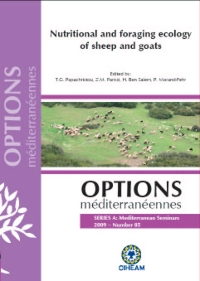| Article précédent | p. 181-184 | Article suivant |
Growth performance of hair sheep at pasture, supplemented with tropical legume (Mimosa caesalpiniifolia Benth) rich in condensed tannins
Sansão do campo (Mimosa caesalpiniifolia Benth), a tropical legume with origin in the semi-arid region of Brazil containing approximately 12% condensed tannin (CT), was used to evaluate its effect on the performance of hair sheep at pasture. Eighteen lambs, with liveweight of 16.9 ± 1.87 kg, were divided in three treatments: control (C) (68% corn + 32% soybean meal), sansão do campo (S) (60% sansão do campo + 30% corn + 10% soybean meal) and sansão do campo with polyethylene-glycol 4000 (S+PEG) (S + 10 g PEG/animal/day). All sheep were kept together on a 1 hectare of Panicum maximum Jacq. cv. Tanzânia pasture. Each individual animal received 200 g/day of the supplement. CT content did not exceed 3% of dry matter (DM) in the diet. Pasture was collected and animals weighed fortnightly. Feed was analysed for DM, crude protein, neutral-detergent fiber, acid-detergent fiber, ether extract and ash. Concentrate analyses for group C (879, 214, 289, 49, 15 and 16 g/kg DM respectively) and S (876, 210, 532, 189, 24 and 15 g/kg DM respectively) as well as for forage (283, 89, 658, 388, 27 and 48 g/kg DM respectively) were available. After 105 days, group C lambs showed higher (P < 0.05) liveweight (27.4 kg), total gain (10.1 kg) and mean daily gain (96.5 g/day) compared with group S (22.7 kg, 6.0 kg and 56.8 g/animal/day respectively) and group S+PEG (23.8 kg, 7.0 kg and 66.8 g/animal/day, respectively). Although animals from group S+PEG showed higher values than S for the traits analyzed, the differences were not significant (P > 0.05). The best performance in the control group was due to the higher available energy level in this supplement. Although the CT in the sansão do campo had little effect on the performance of the sheep, further research would be necessary to know its effect over long periods of supplementation.
Mimosa caesalpiniifolia Benth est une légumineuse tropicale relativement riche en tannins condensés (environ 12%) originaire de la région semi-aride du Brésil et utilisée en alimentation animale. Dix-huit agneaux délainés de poids vif 16,9 ± 1,87 kg ont été répartis en trois groupes de 6 animaux chacun placés dans 1 ha de Panicum maximum Jacq. cv. Tanzania et recevant une supplémentation de 200 g/animal/jour de trois types de concentrés iso-protéiques. La teneur en tannins condensés du régime n'a pas dépassé 3% : contrôle (C) (68% maïs + 32% son de soja), sansão du champ (S) (60% sansão du champ + 30% maïs + 10% son de soja) et sansão avec polyéthylène-glycol (S+PEG) (S + 10 g PEG/animal/jour). L'échantillonnage de l'herbe et la pesée des animaux ont été réalisés tous les 14 jours. Les teneurs en matière sèche, matières azotées totales, NDF, ADF, extrait éthéré et cendres des aliments ont été, respectivement, de : 879, 214, 33, 15 et 16 g/kg MS, pour C, 876, 210, 129, 24 et 15 g/kg MS pour S, et 283, 89, 755, 375, 27 et 48 g/kg MS pour le fourrage. Après 105 jours les agneaux du groupe C avaient un poids vif de 27,4 kg, un gain de poids de 10,1 kg et une croissance journalière de 96,5 g. La meilleure performance enregistrée chez les ovins du groupe contrôle est le résultat d'une faible teneur en fibre du concentré. Bien que les tannins condensés du sansão du champ ne semblent pas affecter les performances des ovins, il est recommandé d'évaluer leurs effets pendant des périodes plus longues.
- [ Afficher ]
- [ Télécharger ]
- [ Exporter la citation ]
Vous pouvez télécharger la citation au format :
- [ Imprimer ]
-
Mots-clés
AGNEAU, BRESIL, FOURRAGE, NUTRITION ANIMALE, OVIN, TANNINCiter cet article
Campos G.M., Louvandini H., McManus C.M., Cabral Filho S.L.S., Garcia J.A.S., Abdalla A.L. Growth performance of hair sheep at pasture, supplemented with tropical legume (Mimosa caesalpiniifolia Benth) rich in condensed tannins. In : Papachristou T.G. (ed.), Parissi Z.M. (ed.), Ben Salem H. (ed.), Morand-Fehr P. (ed.). Nutritional and foraging ecology of sheep and goats. Zaragoza : CIHEAM / FAO / NAGREF, 2009. p. 181-184. (Options Méditerranéennes : Série A. Séminaires Méditerranéens; n. 85). 12. Seminar on: Nutritional and Foraging Ecology of Sheep and Goats, 2007/10/11-13, Thessaloniki (Greece). http://om.ciheam.org/om/pdf/a85/00801005.pdf



